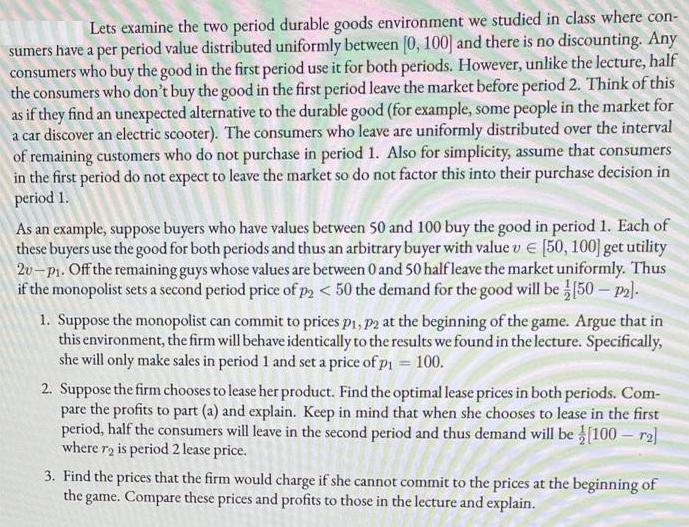Answered step by step
Verified Expert Solution
Question
1 Approved Answer
Lets examine the two period durable goods environment we studied in class where con- sumers have a per period value distributed uniformly between [0,

Lets examine the two period durable goods environment we studied in class where con- sumers have a per period value distributed uniformly between [0, 100] and there is no discounting. Any consumers who buy the good in the first period use it for both periods. However, unlike the lecture, half the consumers who don't buy the good in the first period leave the market before period 2. Think of this as if they find an unexpected alternative to the durable good (for example, some people in the market for a car discover an electric scooter). The consumers who leave are uniformly distributed over the interval of remaining customers who do not purchase in period 1. Also for simplicity, assume that consumers in the first period do not expect to leave the market so do not factor this into their purchase decision in period 1. As an example, suppose buyers who have values between 50 and 100 buy the good in period 1. Each of these buyers use the good for both periods and thus an arbitrary buyer with value v [50, 100] get utility 20-P. Off the remaining guys whose values are between 0 and 50 half leave the market uniformly. Thus if the monopolist sets a second period price of p2 < 50 the demand for the good will be [50-p2]. 1. Suppose the monopolist can commit to prices p1, p2 at the beginning of the game. Argue that in this environment, the firm will behave identically to the results we found in the lecture. Specifically, she will only make sales in period 1 and set a price of p = 100. 2. Suppose the firm chooses to lease her product. Find the optimal lease prices in both periods. Com- pare the profits to part (a) and explain. Keep in mind that when she chooses to lease in the first period, half the consumers will leave in the second period and thus demand will be [100-r2] where r is period 2 lease price. 3. Find the prices that the firm would charge if she cannot commit to the prices at the beginning of the game. Compare these prices and profits to those in the lecture and explain.
Step by Step Solution
★★★★★
3.38 Rating (151 Votes )
There are 3 Steps involved in it
Step: 1
1 Suppose the monopolist can commit to prices P1 P2 at the beginning of the game Argue that in this environment the firm will behave identically to the results we found in the lecture Specifically she ...
Get Instant Access to Expert-Tailored Solutions
See step-by-step solutions with expert insights and AI powered tools for academic success
Step: 2

Step: 3

Ace Your Homework with AI
Get the answers you need in no time with our AI-driven, step-by-step assistance
Get Started


